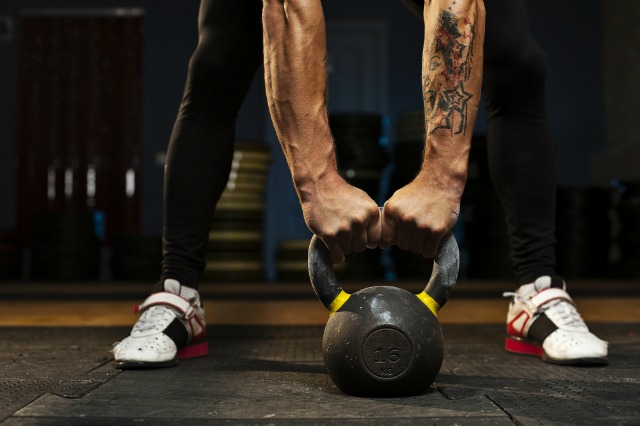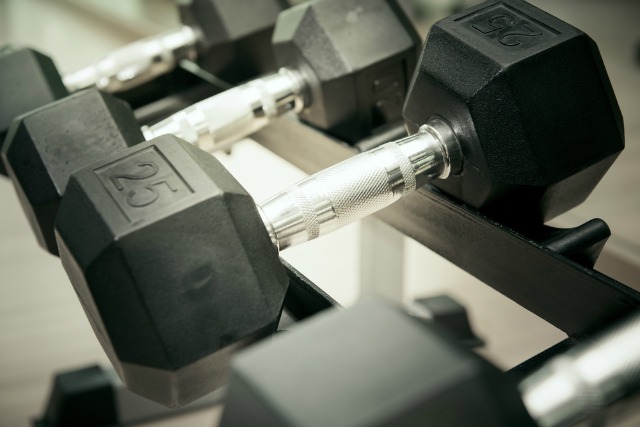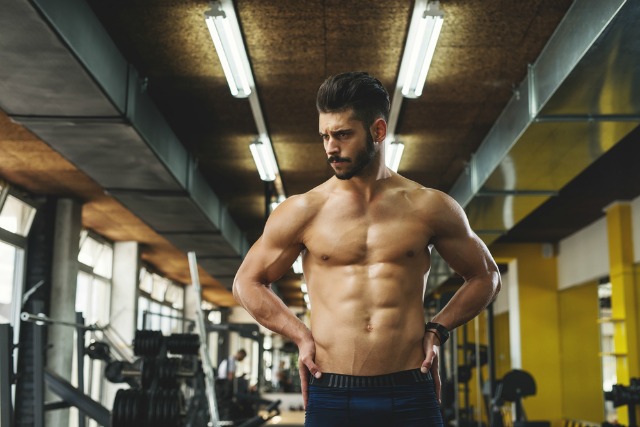How To Get Fit Without Leaving Your Apartment In 2017
By Rachel Cromidas in Arts & Entertainment on Jan 6, 2017 3:30PM

Kettlebell. via Shutterstock.
So you want to exercise more this year, but 2016 left a burnt out wasteland of awful in its wake—and besides, it's winter. I can't blame you if you don't want to leave the house.
You don't need a Couch-to-5K program to get healthier, and you definitely don't need to spend $34 a pop to sweat it out shoulder-to-yuppie-shoulder with 40 other people in an overheated room while some vaguely certified fitness guru yells at you to "dig deeper" and "breathe." You don't even need to leave your 320 square-foot studio apartment.
I used to go jogging a lot, but besides that I had no clue what I was doing. No one told me that jogging every day was never going to make me any any less incapable of doing a pull-up, or any better at moving the couch closer to the TV without hurting my back.
I’d read that building muscle could help me improve my bone density, protect my body from injuries that result from being clumsy as fuck, and ideally make me leaner and less likely to die of heart disease. However, I didn’t know any actual workouts that would help me accomplish this. Fortunately, my sweet online journalism earnings enabled me to invest in a gym membership and a personal trainer, who set the record straight for me. But you don't need any of that stuff to get in shape, either.
This is my officer worker’s guide to building muscle and getting healthier, tailored for people who can’t afford a gym membership, or just don’t like leaving their apartments. I'm not a certified fitness trainer, I'm not a registered dietician, and I don't have a degree in sports medicine. But I am a very sedentary writer who knew nothing about how her muscles worked in 2015, and now I can deadlift 250 lbs without hurting myself. What follows are my opinions on how to get started with weightlifting, based on what really worked for me. Plus, scroll down for a bonus polemic on why I think "losing weight" is a bad goal and "building strength" is a much better one.

Dumbbells. Via Shutterstock.
Getting Started
Don't Try To Work Out Every Day, Or Multiple Hours A Day
You do not need to work out every day—in fact, please don't do this, it could make you more prone to injury. If you've never worked out before, start by working out twice a week, and then slowly add on to your workout schedule. if you're already used to exercising every day (runners, I see you), cut back to four times a week and see how that feels. You don't need to work out more than three to four times a week to see changes to your body and strength. You also don't need to spend a big chunk of time working out in a day. Listen to your body, and plan to do up to an hour long workout. It's OK if you need to start slow, and work your way up from, say, 15 or 20 minutes. You can start there, then add a little time to your workout each week as you start to see improvements.
Equip Your Home Gym
You don't need a lot of fancy equipment to get a great workout; but the more variety you have, the more you can do—that's why some people who know how to work out on their own still have gym memberships. Assuming you don't have the time, money or inclination to get a gym membership, I recommend equipping yourself with as many of the following items as possible. If you can't buy it new, try buying second-hand or borrowing from a friend who's Marie Kondo-ing their shit this year.
Yoga mat: Lots of bodyweight workouts will require you to rest your hands, elbows, arms or knees on the ground, and a yoga mat will make this easier, especially if you have hardwood floors.
Foam roller and lacrosse ball: If you're building your muscles, they're going to get sore. When that happens, you're going to want to invest in a foam roller and/or a rubber lacrosse ball that can help release tension in your muscles and improve your muscle mobility. The jury is still out on the benefits of stretching before a workout, but I find the evidence in favor of foam rolling very compelling. The technical term is self-myofascial release, and it it feels fantastic and like you've opened up the Hellmouth in your muscles at the same time. Have fun.
Pull-up bar: Pull-ups are incredible—they recruit an orchestra of upper body muscles to safely lift your entire weight into the air. When you do your first pull-up, you'll feel like you climbed a mountain, but with the effort condensed into the span of three seconds. You'll also feel like a complete badass, because that's what you are when you can do a pull-up. But before you can do your first pull-up, you have to do ~500 negative pull-ups, a.k.a. jump pull-ups, and you'll need a pull-up bar to get started. I recommend Sweethome's guide to buying a pull-up bar.
Free weights: You can get an amazing and brutal workout using just your body weight. But you can do even more with a few free weights, which is why I'm recommending you save up or ask around and try to acquire at least three weights: a pair of medium-challenging weights you can lift for sets of 8 to 12, and a heavier weight that you can't lift much more than 5 to 7 times. Everyone's starting weight is different: as a novice I started with two 10 lb kettlebells and one 30 lb kettlebell, because I personally find kettlebells easier to hold than dumbbells. Now I use two 18 lb kettlebells and two 45 lb kettlebells for most of my workouts. You can use kettlebells, dumbbells, a medicine ball, a barbell, or some other heavy object. As long as you are challenging yourself, don't worry about starting small, because everyone has to start somewhere. If you follow a workout consistently, you'll make progress quickly and need to buy more weights before you know it. Get started with a friend, and maybe they'll be ready to hand off a heavier weight to you when you're ready to move up.

Woman holds a plank, also known as the top position of a push-up. You will spend a lot of time in this position if you want to work out without any weights. Via Shutterstock.
Planning Your Workout
Before you start swinging weights around your home like a maniac, you'll want to write a detailed workout plan and get a 5 to 10 minute warm up in. Your warm up will depend on what muscle groups you plan to use, and your workout program will depend on what tools are available to you. I've compiled some links to some good free resources for planning your warm-up and workout. I recommend aiming for a mix of workouts that target your lower body, upper body and core, and require a mix of pushing and pulling. (Examples: a deadlift is a pull lift. A pull-up is a pull lift. A squat is a push lift. A push-up is a push lift.) Mix and match depending on what tools are available. If something hurts, just don't do it. When something gets too easy, add weight, or add reps—that’s short for repetitions.
Form: You'll also want to make sure you have proper form, or else your efforts will be wasted. You can check your form by yourself by videotaping your workouts with a camera phone or computer camera, and then comparing them to videos online. This might sound like a lot of work, but it's much better than trying to check your form in a mirror and accidentally straining your neck when you should be keeping it in a neutral position.
Warming up: Before you do anything that could strain your muscles, you want your muscles to be engaged and mobile. You can accomplish this with a quick routine of self-myofascial release and active stretching. This is especially important if you spend any amount of your day slumped on a couch or hunched over a computer.
Read about why to foam roll and how to foam roll, and watch a video of a full-body foam roll exercise and seven foam rolling exercises.
These videos show how to get started using a lacrosse ball for myofascial release, and specifically to relieve hip and back tension.
Here's a list of dynamic stretching workouts, a video on all the basics that I like to incorporate into my warm-ups, and one that specifically targets hip mobility.
Bodyweight workouts:
Full bodyweight workout primer.
15 minute abs workout.
Pull-up bar workout for abs.
How to do your first pull-up.
Kettlebell and dumbbell workouts:
A 12-week beginner's guide to kettlebells.
All levels kettlebell workout video.
10-minutes kettlebell workout video.
8 great dumbbell or kettlebell workouts.
Total body Dumbbell workout.
Beginner's guide to the dumbbell bent over row.
How to do a Turkish get up—a great full body exercise.
And if you have access the extra equipment for it,
This Stronglifts 5x5 workout plan will run you through five major lifts and make each one stronger over time.
Cardio:
If you are aiming to become leaner, improve your cardiovascular endurance or lower your risk of heart disease, try doing 10 to 20 minutes of High Intensity Interval Training 2 to 4 times a week. You can google HIIT for some ideas. I like sprinting on stairs, but that requires going outside, and I promised I wouldn't make you do that. Here's some HIIT you can do from the safety of your home:
A beginner's guide to jump rope workouts.
Bodyweight cardio workouts.
Bodyweight circuit workouts.
Introduction to the kettlebell swing. The kettlebell swing is a great cardiovascular workout, but it is particularly important to have proper form when doing this exercise. Please keep your core tight, and don't lift the weight with your arms; the force that lifts the weight comes from your legs and hip thrust.

Diver Scallops. Photo by Kaitlyn McQuaid.
What To Do When You're Not Working Out
Eating: After you workout, there's still a bit more work to be done. If you're going to be working on building muscles, you'll need to eat enough protein. Many trainers recommend eating at least .6 to 1 gram of protein per pound you weigh. Speaking from experience, this is harder than it might sound. I used to be a vegetarian, and when I finally started tracking my protein I realized I was only eating about 50 grams a day—less than half what I need to build muscle. Now I aim for at least 100 grams a day—but I'm a relatively small person, meaning you'll probably need to eat more. Hope you like eating, because you'll need to do it a lot. You should also drink more water to help your muscles recover.
Rest: Like the advice to drink more water, rest is something I can't recommend enough, especially if you want your muscles to recover and you want to see yourself make progress toward your muscle-building goals. I know we're all busy, but aim to get more sleep. And when you're resting, but awake, pay attention to how you're sitting and how you're using your body. If life requires you to look at a computer all day, take a quick break when you feel your neck or knees getting stiff, for example, and do some mobility drills.
Moving More In General: This is the part where I admit that I've been lying to you: I do want you to leave your apartment after all. They say that sitting is the new smoking, and while that assessment might be a bit extreme, moving your body at a low intensity throughout the day when you're not working out will have a small but important impact on your wellness. Try biking or walking instead of driving, or try out a yoga class.

A man who is more shredded than me. Via Shutterstock.
Will These Workouts Make Me Look Shredded And Hot?
Probably not.
Looking "fit"—by which I mean, looking like you might belong on the cover of a fitness magazine—requires achieving muscle hypertrophy (that means making your muscles bigger) while having a low body fat percentage, and that means restricting calories, and that sucks (and that's why none of my advice is about calories). You really don't have to lose weight or shrink your body fat to feel healthier and get stronger, and your weight should not be viewed as a measure of your progress. I still have days when my body image is low, but strength training has taken me a long way toward appreciating what my body can do, as opposed to how it looks. This is good for my mental health, and it's good for my longevity, and that's a solid combination that can work for you, too. Make 2017 your year of gains. Then challenge everyone in your office to a pull-up competition.